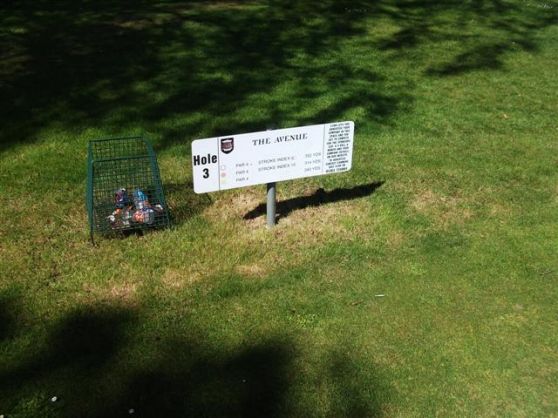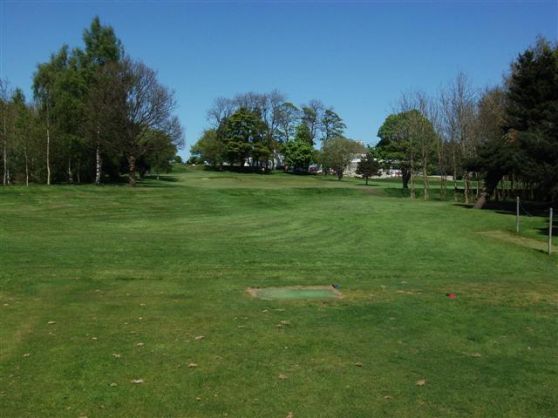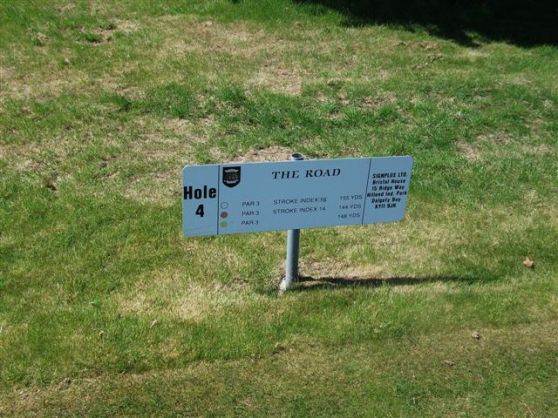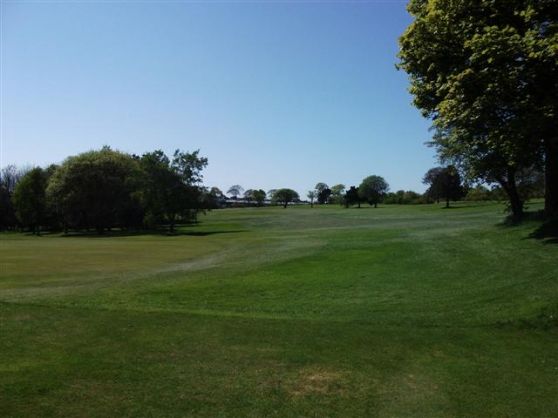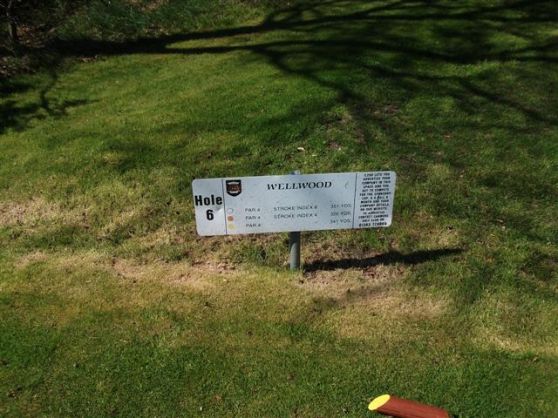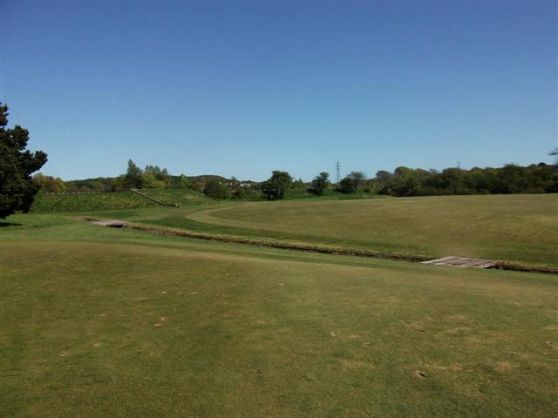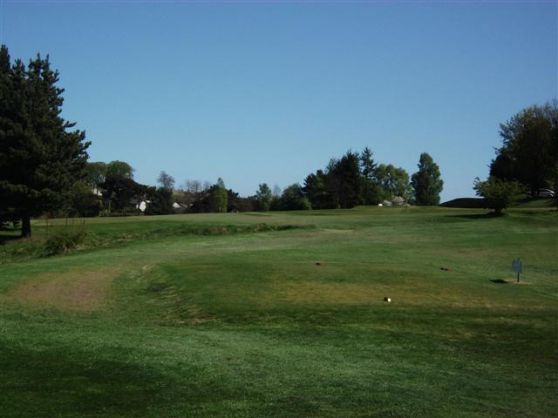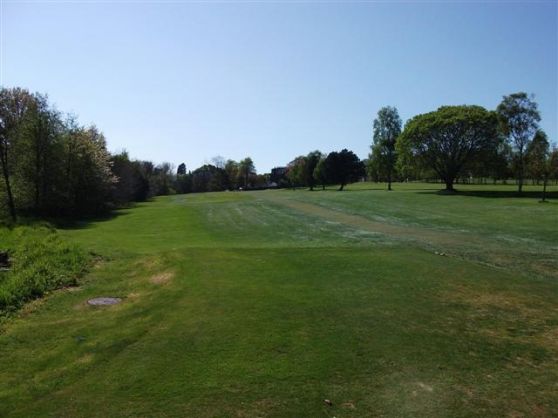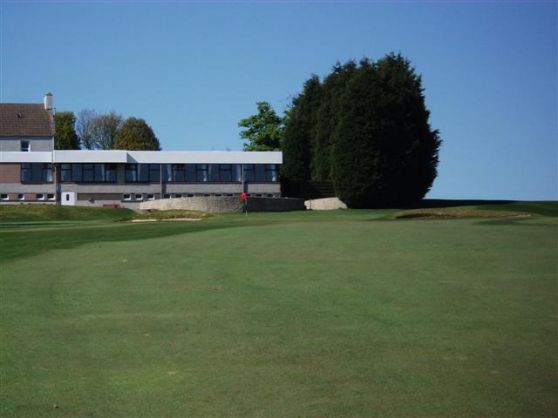- Hole 1
- Hole 2
- Hole 3
- Hole 4
- Hole 5
- Hole 6
- Hole 7
- Hole 8
- Hole 9
- Hole 10
- Hole 11
- Hole 12
- Hole 13
- Hole 14
- Hole 15
- Hole 16
- Hole 17
- Hole 18
Hole 1
Hole 1 : Centenary
A short Par 4 to start but not without difficulty. A large bunker will swallow up any offline lay up shots and further bunkers to either side of the green will catch any errant tee shots going for the green. The green itself slopes quite severely from front to back and requires a delicate approach to hit and hold the green.
Pro’s Tip :
This hole can be played in two ways. If you are a longer hitter and can carry the ball over 190 yards, allowing you to fly over the large fairway bunker, then going for the green is a good play. However, if you cannot then the best strategy is to play a lay up shot, short of the large fairway bunker, which will leave a wedge or short iron to the green.
Hole 2
Hole 2 : Queen Anne
A fairly long Par 4, with driving accuracy imperative should you want to hit the green in two ! The trees bordering both sides of the fairway give the impression that it is more narrow than it actually is. Approach shots to the green should favour the right hand side to allow the ball to feed onto the green.
Pro’s Tip :
A very difficult hole that plays into the prevailing wind. Accuracy off the tee is critical as hitting the fairway will allow you to more easily advance the ball up towards the green with your next shot. Even though this is a long hole I would suggest leaving the driver in the bag for a more lofted (and therefore potentially more accurate) club which will result in hitting the fairway more, allowing you to play a better quality second shot. Remember this is Stroke Index 1 for a reason meaning that unless you play off scratch or better then you are getting a shot here. Use it!
Hole 3
Hole 3 : The Avenue
A difficult green to hit and hold means that the tee shot is very important on this hole. Trees on both sides of the fairway and an out of bounds down the left hand side increase the difficulty. A deep, front left bunker, a false front and a severe slope off to the right means that club selection is very important to the approach shot which should favour the left half of the green leaving a fairly flat putt.
Pro’s Tip :
Not an overly long hole but a difficult green can cause real problems. Aiming your tee shot for the left half of the fairway allows for an easier approach by removing the need to play over the right hand greenside bunker. When playing to the green aim for the back left quarter as this is the flattest and most forgiving area.
Hole 4
Hole 4 : The Road
The first of five Par 3’s on the course and is the second shortest of them all. An elevation change and a plateau green means that club selection can be difficult. Couple this with bunkers short and left as well as a green that slopes back to front results in a tricky hole.
Pro’s Tip :
Club selection is paramount here as missing the green can leave a very tough up and down. The hole tends to play at least one club longer than you would normally hit for the distance due to the elevation change so aiming for the middle, to back, portion of the green will ensure you get there. Beware though, that hitting the ball to the back of the green usually leaves a very quick downhill putt if you are past the pin !
Hole 5
Hole 5 : Venturefair
Fairly straightforward driving hole with a generous fairway. The green is fast and slopes from right to left meaning that most approach shots will have to be played short and to the right to allow the ball to finish on the green unless you are able to hit the ball very high and can get it to stop on a dime!
Pro’s Tip :
Favouring the left half of the fairway is the easiest way to play this hole. Doing so not only avoids the fairway bunker but also allows for an easier approach shot as you are hitting the shot more into the up slope of the green. All shots played to the green MUST be played to the right half as any shots hit left at all will run off and can leave a difficult up and down.
Hole 6
Hole 6 : Wellwood
Trees and out of bounds up the left hand side of this hole make for a more difficult tee shot which most players will naturally favour to the right half. The fairway slopes from left to right meaning that anyone that doesn’t take the brave route up the left of the hole will more often than not have their ball run into the first or second cut of rough. Playing from the right hand side is far more difficult than the left as you are approaching the green over a bunker and across the narrowest part of it.
Pro’s Tip :
Most tee shots will finish on the right half of the fairway or in the rough due to the left to right slope, meaning that going for the green in two can be very difficult. This hole plays longer than its yardage due to it sloping uphill, therefore, unless you are very confident with your mid to long irons or are a big enough hitter to leave yourself a short iron for the approach shot I would suggest laying up short of the green to the left hand side with your second shot. This will leave a straight forward pitch to the green and will help to reduce the chances of running up a big number.
Hole 7
Hole 7 : The Lade
The shortest hole on the course and stroke index 18 may give the belief that this hole is easy, however, overshooting the green can leave a very tough up and down, especially with a back pin position. Bunkers on either side of the green and one short mean that a high, accurate tee shot is required here.
Pro’s Tip :
A short hole but can destroy a scorecard if taken lightly. The safest way to play this hole is to land the ball short and allow it to run down onto the green. If you are looking to fly the ball all the way you will have to aim for the back half of the green as the up slope will help stop the ball. Landing the ball on the front half of the green will more often than not lead to the ball running through the back.
Hole 8
Hole 8 : Janefield
One of the most daunting tee shots on the course with trees hugging the left hand side and out of bounds on the right. A fairway that slopes sharply uphill means that the hole plays longer than it’s yardage and often leaves a blind shot to the green if your tee shot doesn’t get far enough up the hill. An out of bounds close to the back of the green and bunkers either side make accuracy and correct club selection a must with the approach shot.
Pro’s Tip :
The length you hit the ball off the tee will completely change the way this hole should be played. If you are a fairly long hitter then the best option is to simply grip it and rip it with the driver as the fairway is fairly generous once you are past the out of bounds field on the right. However, if you are a shorter hitter the out of bounds on the right hand side is very much in play and as such the best strategy is to play a club off the tee that you are confident with and aim to land the ball in the flat fairway portion short of the up slope. Laying up off the tee will leave a much easier approach shot than hitting a mid to long iron from an uphill lie.
Hole 9
Hole 9 : The Loch
The 9th hole named “The Loch” refers to Townhill Loch that is situated to the left of the green and overlooks the hole. A concrete drainage ditch hazard that cuts the fairway in half is well in range of a lot of players off the tee and forces players to choose whether to lay up short and leave a longer approach or gamble that they can carry it and leave a shorter shot in. Carrying the ditch leaves a much easier shot to a green that is surrounded with long grass bankings and a greenside bunker on the right. Risk and reward!
Pro’s Tip :
Once again, club selection off the tee is the key to playing this hole correctly. If you are a long hitter and can carry the ball over 250 yards then hitting driver over the ditch is the best idea as this will significantly shorten the hole making the next shot a lot easier. For most players, however, this will not be the case and as such the best course of action is to leave the ball short of the ditch and in the best possible position off the tee to allow for a good quality second shot. The optimum landing area is around 190 to 200 yards as this will leave around a 175 yard shot to the green from a flat lie. Any further will leave you on a down slope and potentially may even run into the hazard, resulting in a penalty stroke.
Hole 10
Hole 10 : The Burn
The back nine starts with four tough holes and, along with the 8th hole, this tee shot is probably the biggest cause of many ruined scorecards. A fairway sloping towards the out of bounds coupled with a prevailing head wind make for a very challenging hole!
Pro’s Tip :
A very tough hole that plays into the prevailing wind and as such feels a lot longer than it’s yardage states. Out of bounds runs the entire length of the hole down the left hand side and the fairway slopes towards it meaning that tee shots will naturally favour the right hand side. If you can take the brave route and skirt the out of bounds on the left this will leave a flat approach to the green, however, if you opt to bail out and hit it to the right a much tougher approach awaits, which may even be blind depending on how far back you are. When playing to the green, the bail out area is to the right so I would suggest aiming to finish the ball on the right half of the green to give the greatest amount of leeway.
Hole 11
Hole 11 : Quarry
The signature hole at Canmore GC is number 11 “Quarry”. This is aptly named as the green sits well below the level of the fairway and is blind on the approach. A tee shot of up to 240 yards will leave a mid to short iron into the green which has a marker pole to indicate the direction. The only safe area to miss this green is short as a burn and out of bounds are long and left with bunkers both left and right. It really is a case of green or bust!
Pro’s Tip :
A fairly straight forward tee shot with the only danger being a fairway bunker on the left hand side at 170 yards from the red/yellow tees or 211 yards from the medal tees. Long hitters beware that the ideal landing zone off the tee is about 30 yards past the bunker, meaning that driver is usually not the correct choice. The real difficulty of this hole lies in the shot to the green, which is blind and fraught with danger. The best strategy for this hole is to assess whether you are confident in hitting the green with the club you require, as missing the green can very often result in a high score being racked up. Laying up to the side of the mound and leaving a 90 – 100 yard shot to the green may be the best course of action if you are far back off the tee.
Hole 12
Hole 12 : Spion Kop
The third of four tough starting holes on the back nine is number 12. The longest Par 3 on the course at 200 yards off the medal tees means a long tee shot is required. Bunkers to the right of the green and a gully full of long grass make this an intimidating shot.
Pro’s Tip :
The greatest danger on this hole is coming up short as all of the danger is in front of the green. The most effective way to play this hole is to aim for the back of the green as this will allow room for a miss hit and if the ball does run through the back there are no dangers.
Hole 13
Hole 13 : The Farm
The second Par 3 in a row and although it has a stroke index of 13 it consistently plays as one of the hardest holes on the course. At 188 yards it is fairly long and with out of bounds to the left, a deep greenside bunker on the right and a green that slopes severely from left to right, this is a very tough hole. Walking away with a 3 feels like birdie.
Pro’s Tip :
Probably the hardest green on the course which is notoriously fast and sloping meaning that leaving the ball in the correct place off the tee is extremely important. The out of bounds on the left will make most players miss this green to the right, however, if the ball manages to get pin high then missing the green to the right isn’t actually that bad as it will leave a straight forward chip up the hill giving a good chance to save par. The tee shot should be aimed to the left side of the green to have the best chance of holding it, however, make sure you take plenty club as leaving it short will catch the deep bunker front right, resulting in a hard sand save for par !
Hole 14
Hole 14 : Headwell
Hole 14 is a welcome break after 4 tough holes in a row, although it is not without danger as trees border both sides of the fairway. At 347 yards and running steeply downhill, meaning that it plays a lot shorter than its yardage, long hitters can go for the green or at least get very close. Due to how short the hole plays an iron or hybrid off the tee will still only leave a fairly short approach shot and is a good strategy for anyone hanging on to a score.
Pro’s Tip :
One of the easier holes on the back nine, providing you play it smartly. The steep downhill gradient means that the hole plays very short and as a result the safest strategy is to use a club that you are confident of hitting the fairway with off the tee. One thing to note is that playing from a downhill lie will cause the ball to come off the face lower, resulting in more carry through the air and a firmer bounce upon landing. Take this into account when selecting the club for the approach shot as missing the green long is very dangerous.
Hole 15
Hole 15 : Bleachfield
The final Par 3 at Canmore GC is once again fairly tricky. There is a large greenside bunker on the right and, as the green slopes from right to left, this forces players to hit over the bunker to have any chance of holding the green. Further bunkers short and to the left stop you trying to run a low shot into this green.
Pro’s Tip :
A tough green to hold as the slope of the green forces you to play over the deep greenside bunker on the right. If you are unable to hit a high ball flight that stops quickly then the best way to play this hole is to hit a club that carries the bunker short of the green and allow the ball to chase onto the green. The best place to miss this green is on the left as there are no bunkers meaning a far more straight forward up and down.
Hole 16
Hole 16 : Broomfield
Probably the most birdied hole on the course and a stroke index of 17 confirms this. A short par 4 of only 258 yards means that the green is in range for a lot of players, but beware missing to the right off the tee leaves an extremely difficult approach shot as the green is small and very firm.
Pro’s Tip :
A real birdie chance due to the length, however, it has the potential to cause problems if you are out of position off the tee or miss the green on the wrong side. Longer hitters can go for the green and potentially have an eagle putt or a short shot remaining, although this can be a gamble due to the firm green and missing it on the same side as the flag will result in a nigh on impossible shot to get close. Shorter hitters should lay up to a distance they are comfortable with to allow them to hit the green more often. Avoiding the fairway bunker at 180 yards is essential as landing in this will make the hole far more difficult. Approach shots to the green should be played to land short and right to allow them to bounce down onto the green.
Hole 17
Hole 17 : Sandwich
The longest hole on the course at 430 yards, number 17 is a difficult hole to achieve par on. A thick patch of trees run along the left hand side of the fairway leading up to the green but sparse trees on either side leading up to this means that the tee shot appears fairly generous. Do not be fooled by this as a bunker on the right of the fairway at around 210 yards will catch any errant tee shots and makes hitting the green in 2 substantially harder. A large bunker short of the green on the right and a greenside bunker on the left means that accuracy is key when playing the approach shot to this large green.
Pro’s Tip :
Avoiding the fairway bunker is key to having a chance at hitting the green in two and recording a par on this long hole. Favouring the left hand side of the fairway off the tee will eliminate the bunker and also offer a straight line into the green. A fairly generous opening to the green means that the ball can be run onto it from long range, however, unless you are confident of doing so I would suggest laying up short of the two greenside bunkers and relying on a chip and putt for par as catching the sand traps will cause problems.
Hole 18
Hole 18 : Up the Hill
The final hole runs steeply uphill and makes the hole play considerably longer than its yardage due to this, however, if you have the power to carry to the top of the the initial steep slope then the hole is massively more manageable. Fairway bunkers to the left and right are like magnets to off centre tee shots and catching one of those almost always removes the possibility of going for the green, meaning an up and down for par!
Pro’s Tip :
Tee shots will lose distance due to the steep upslope resulting in a longer approach shot than you might expect given the yardage of the hole. Once again, avoiding the fairway bunkers left and right is paramount to scoring well on this hole and if this means taking less club off the tee to ensure you don’t go in them then this is a better strategy than trying to squeeze out a few extra yards and catching the sand. When playing to the green try to leave the ball below the hole as the green slopes from back to front and is very fast, meaning that a three putt is a very real possibility if you overshoot the pin.







